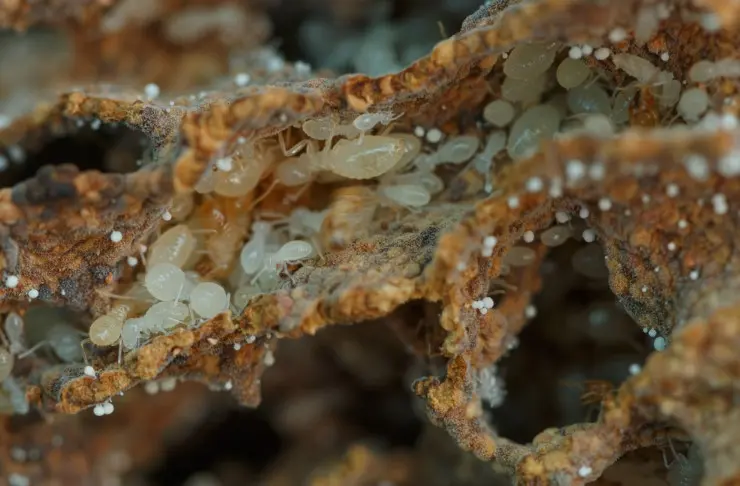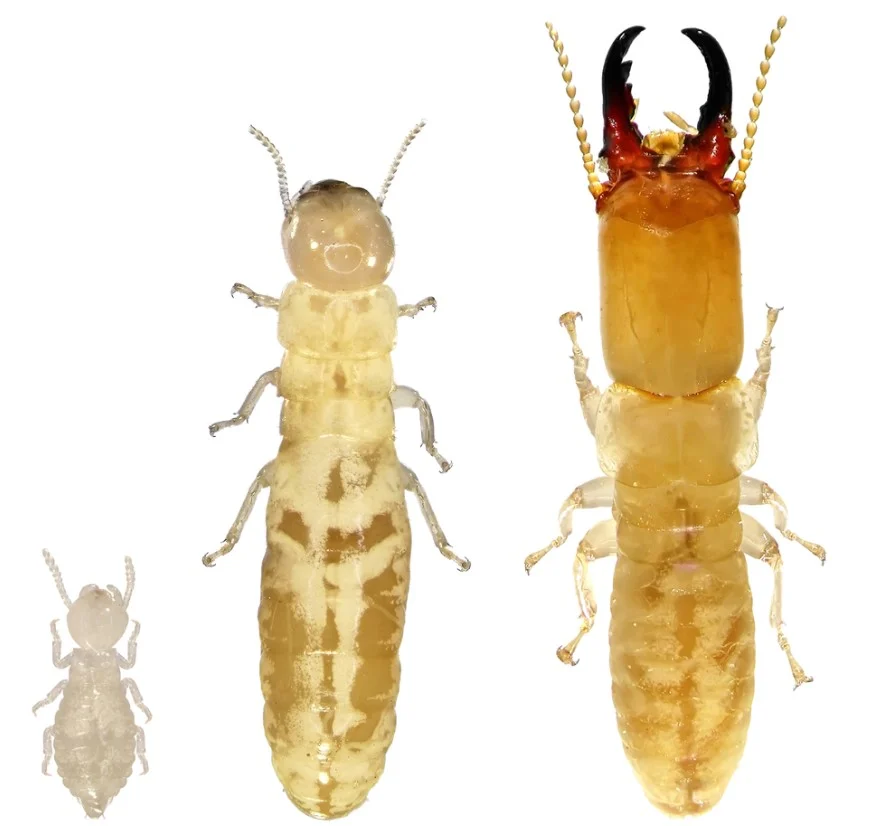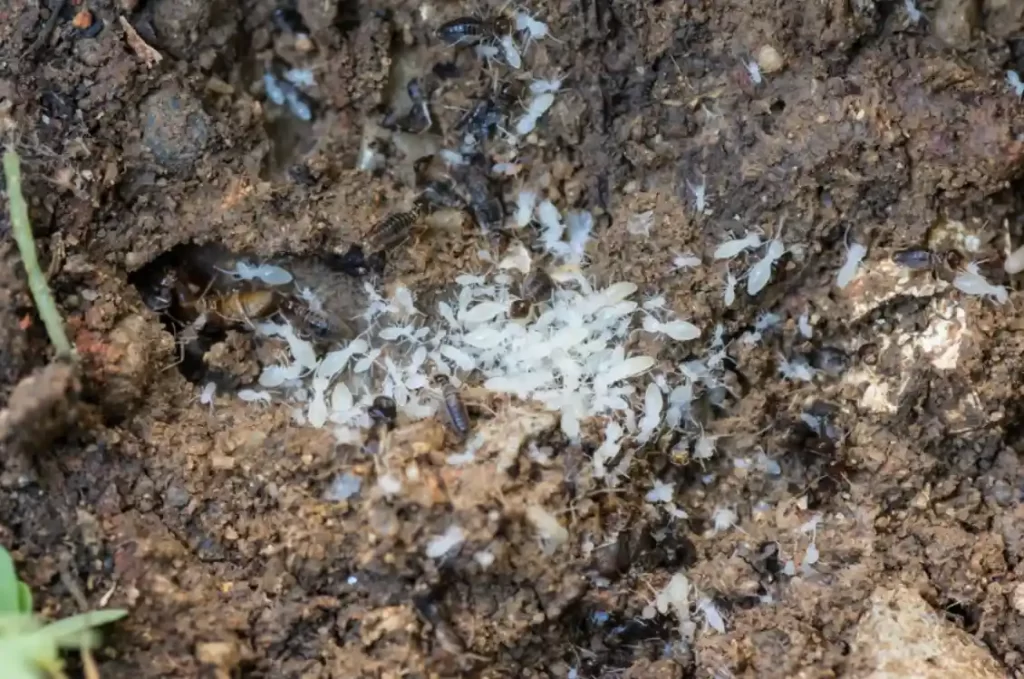Niemand möchte irgendeine Art von Insekt in seinem Haus haben, aber Termitenbabys sind besonders verhasst. Wenn Sie kleine, flügellose und ameisenähnliche Insekten in oder um Ihr Haus herum sehen, sollten Sie sie nicht für bare Münze nehmen, da sie irreparable Schäden an Ihrem Haus verursachen können.
Wenn Ihr Haus, Ihre Garage oder Ihr Lagerraum von Termiten befallen wird, kann der Schaden mehrere zehntausend Dollar betragen. In den Vereinigten Staaten werden jedes Jahr Sachschäden im Wert von fast einer Milliarde Dollar auf Termiten zurückgeführt.
Diese Schädlinge ernähren sich gerne in aller Ruhe von der Holzstruktur Ihres Hauses, und die daraus resultierenden Schäden sprechen für sie. Noch beunruhigender ist, dass sie sich, wenn sie nicht gestoppt werden, rasch vermehren und ihre Umgebung dezimieren werden.
Lesen Sie weiter, um zu erfahren, was Sie Wissensbedarf über junge Termiten, wenn Sie die Entscheidung getroffen haben, sie zu entdecken und den Befall von Grund auf zu beseitigen.
Seite Inhalt
Lebenszyklus der Termiten
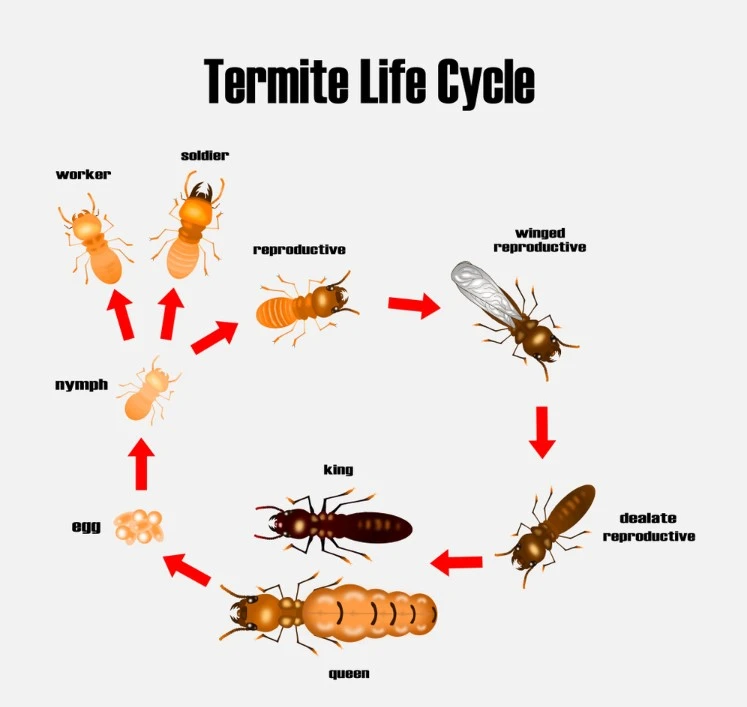
Was sind Baby-Termiten?
Babytermiten sind offensichtlich weiß oder durchscheinend, jung und unreif. Dieses Stadium der Termiten Der Lebenszyklus wird als Nymphe bezeichnet; deshalb werden die Babytermiten auch Nymphen genannt.. Die Nymphen sind klein und befinden sich in diesem Stadium kurz vor dem Erwachsenenalter.
Termitenkönigin, zuständig für alle Angelegenheiten der Kolonie, einschließlich Fortpflanzung und Instandhaltung, legt Eier und brüten sie aus. Nach dem Schlüpfen aus den Eiern werden Termitenbabys oder Nymphen geboren, die dann mehrere Entwicklungsstadien durchlaufen, bis sie das Erwachsenenalter erreichen.
Während der Reifezeit werfen die Termiten ihr Exoskelett mehrmals ab und verändern ihre Farbe.
Babytermiten spielen eine wichtige Rolle für die Sicherheit und Entwicklung der Kolonie. Vom Schutz des Territoriums vor Raubtieren bis zum Sammeln von Nahrung für alle Termiten in der Kolonie arbeiten sie hart.
Außerdem tragen sie auch zum Wachstum der Termitenpopulation bei. Bei Nahrungsknappheit sind sie eine gesunde Nahrungsquelle für erwachsene Termiten, da sie mit Nährstoffen angereichert sind.
Arten von Babytermiten
Während der Entwicklungszeit werden den Babytermiten verschiedene Aufgaben innerhalb der Kolonie zugewiesen. Die Kolonie wird nach der Art der ihnen zugewiesenen Arbeit eingeteilt. Lassen Sie uns die einzelnen Arten und die Art der ihnen zugewiesenen Arbeit besprechen:
Hilfsarbeiter Termiten
Diese Babytermiten sind in großer Zahl vorhanden und haben verschiedene Aufgaben innerhalb der Kolonie. Sie sind für die Suche nach neuen Nahrungsressourcen und das Sammeln von Nahrung in der Kolonie verantwortlich.
Sie sind auch dafür verantwortlich, neue Nester zu finden, diese zu pflegen und für die jungen Termiten zu sorgen.
Man erkennt sie an ihrer weißen oder durchscheinenden Farbe und ihrer winzigen Größe.
Soldaten Termiten
Diese Art von Termiten ist für den Schutz der Kolonie vor Außenstehenden und Raubtieren verantwortlich. Sie sind stärker und größer als die Arbeitertermiten.
Ihr einzigartiges Erscheinungsbild mit größeren Mandibeln oder speziellen Drüsensekreten hebt sie von anderen Termiten der Kolonie ab und weist sie als Verteidiger der Kolonie aus.
Fortpflanzungsfähige Termiten
Diese Art von Termiten ist reifer und entwickelter als andere Arten. Ihre Größe ist auch größer, und sie sind dazu bestimmt, sich zu vermehren und das Wachstum der Termiten in verschiedenen Kolonien zu steigern.
Sie haben Flügel und können von einer Kolonie zur anderen fliegen und mehr als eine Kolonie auf einmal bilden.
Außerdem gibt es zwei Arten von fortpflanzungsfähigen Termiten: primäre Termiten, die für die Eiablage zuständig sind, und sekundäre Termiten, die diese Eier befruchten und ausbrüten, bis sie geboren werden.
Alate-Termiten
Diese Art von Termiten ist erwachsen geworden und hat Flügel, um von der Mutterkolonie zu anderen Kolonien zu fliegen. Sie sind auch als Schwärmer bekannt und helfen fortpflanzungsfähigen Termiten bei der Gründung und Erhaltung neuer Kolonien.
Sie sind auch größer als gewöhnliche Termiten, weil sie sich nach einigen Stadien des Lebenszyklus von Termiten entwickelt haben.
Königin Termiten
Die Termitenkönigin ist das wichtigste Mitglied der Termitenkolonie, die sich fortpflanzt und alle Angelegenheiten der Kolonie regelt. Sie ist die am weitesten entwickelte und reifste Art und in der Regel größer als andere Termitenarten.
Sie kann täglich Hunderte oder Tausende von Eiern legen, wodurch die Population exponentiell ansteigt.
The queen termites are located in the center of the colony and surrounded by other types of termites.
Worker and soldier termites protect and care for queen termites.
The role of each type is crucial, and they play it responsibly, which is why they are very destructive to your home.
Wie klein sind Baby-Termiten?
Generally, the size of baby termites depends upon the stage they are living in and the role they are playing in the colony.
Before reaching adulthood, termites pass through different stages, and their size differs at each stage.
Let’s talk about their body size according to their role or type in the colony:
Laborer termites that collect food for the colony members are the smallest in size and are less developed than each other type.
Soldier termites are healthier and stronger than workers. They are larger in size and have developed larger mandibles to protect the colony from predators.
Reproductive nymphs, which assist in reproduction and maintain new colonies, are more developed and have wings. They can fly from the parent colony to new colonies and retain them in a better way.
Alate termites also have wings and help reproductive termites in settling new colonies. Their size is larger than the soldiers and workers.
Queen termites lay eggs for reproduction in the colony and are larger in size than other types of termites.
Wie sehen Baby-Termiten aus?
Baby termites continuously undergo several stages of development called metamorphosis until they reach the adult termites’ stage.
During these stages of development, they shed their exoskeletons several times and keep changing their appearance at each stage.
Generally, the body appearance of baby termites is pale or white, their size is small, and they are wingless. As they go through metamorphosis, they grow large in size and become mature.
Before reaching adulthood, they are responsible for playing a specific role in the colony’s development.
When fully developed and become adult termites, they turn brown or black and have a segmented body.
They also have wings, thorax, abdomen, stronger mandibles, and antennae on their body.
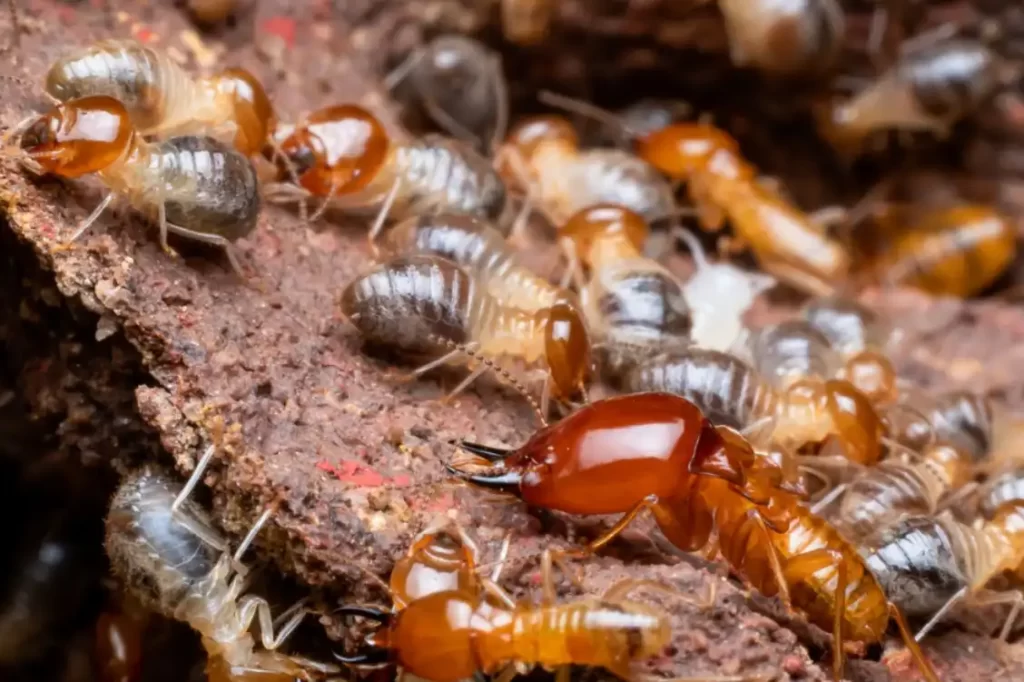
Was fressen Baby-Termiten?
Baby termites are not developed and mature, so they don’t have wings to fly in search of food. Instead, they depend on other termites to care for and feed them.
Termites follow a very strict hierarchy of roles within the colony. It is the duty and responsibility of mature and developed termites to search for food and collect in the colony for baby termites.
Their primary source of food is wood and plant materials. They utilize a special bacterium from their guts to break down the cellulose present in the wood.
In urban areas, they eat the wood structure of buildings and furniture and severely damage them. The food-collecting termites collect these small pieces of wood and bring them back to the colony for baby termites and queens.
Baby termites chew these pieces and then puke this half-processed wood. Then other members of the colony eat this partially digested food. This process of food distribution is called trophallaxis.
Wo leben die Babytermiten?
Termite larvae form colonies and operate according to a strict hierarchy. These communities are housed in subterranean and wooden buildings.
Termites have adapted to a wide variety of environments as a result of environmental disruptions. They populate woodlands, prairies, and even deserts.
Termite offspring are fully dependent on their caregivers—the adults—for everything. Termite nests are located within the colony, and the termite population lives there.
Like mature termites, they are given specialized roles to perform in the colony’s progress as they expand in size and strength.
Können Babytermiten fliegen?
Baby termites are usually rather tiny. Because they are young and underdeveloped, they lack the ability to fly and hunt for food.
They live in colonies with adult termites and are cared for and fed by them. Until they mature and become huge, baby termites spend the most of their time in nests.
Alate is the only termite with wings that can fly from colony to colony. Baby termites go through multiple phases of development before reaching this stage.
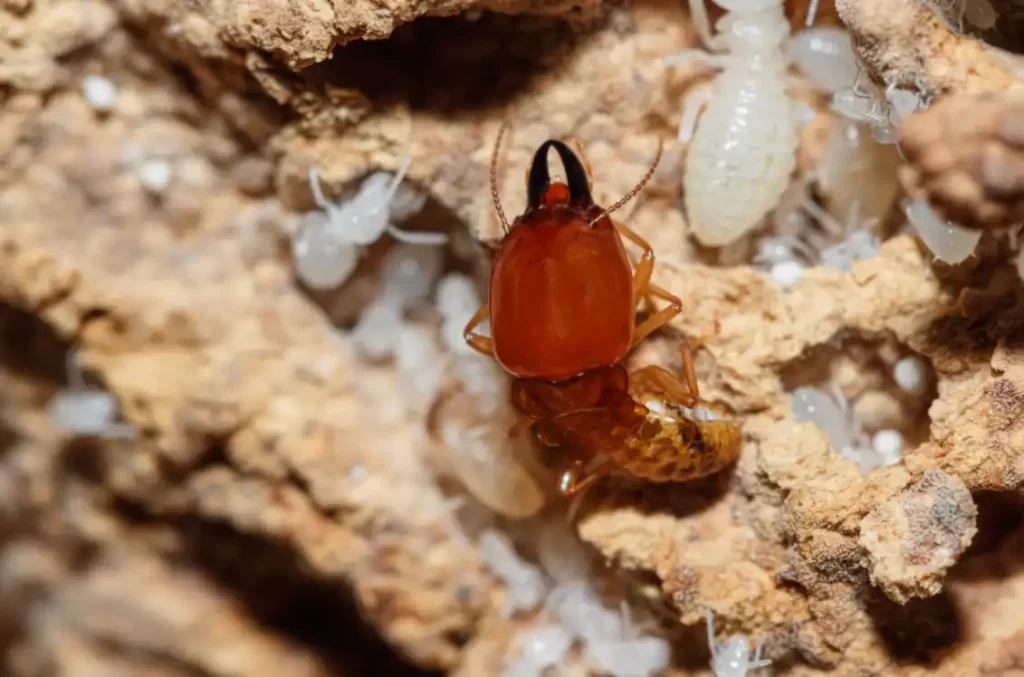
Baby-Termiten gegen Ameisen
Baby termites and ants are quite similar to some extent because they belong to the same group named Hymenoptera, but their families are entirely different.
Although they both are insects and live within large colonies following a strict hierarchy, one major difference is the eating habit of termites, they eat wood, and ants do not.
However, in both families, queens lay eggs and hatch them. Then babies are born as larvae who pass through different development phases to reach adulthood.
Adults of both families feed babies and protect them from external threats until they mature fully.
But another major difference between both families is that in termites colonies, only one queen lives in each colony, while in the case of ants, multiple ant queens can stay in one colony.
Both are similar in many ways and play their essential roles in their colonies according to their family natures.
Babytermiten vs. erwachsene Termiten
Baby termites are nymphs at an immature growth stage. When adult termites lay eggs and hatch them, then nymphs are born and cared for by adult termites till they are fully grown and can survive on their own.
Between baby termites and adult termites, there are several phases that babies have to pass through to reach adulthood.
After egg hatching, the first stage is nymphs or baby termites which are small in size and cannot fly.
Next stage, termites are called soldiers because they are young and stronger. They have developed specific parts of their body that they used to protect the colony.
The next stage termites are known as reproductive termites, and they can fly because they have developed wings and grown large in size.
The last stage is the adult stage. They are fully developed and mature termites that can reproduce and lay eggs to grow their population.
Baby-Termiten im Vergleich zu Maden
Maggots are also immature insects of the flies family, like baby termites from the termites family. They have few traits in common, but there are also many key differences between them. Let’s discuss them one by one.
The primary difference is the parent family of both insects. Maggots are the larvae of the flies’ family and belong to the order Diptera while baby termite is the immature stage of termites and belongs to the order Isoptera.
The second major difference between both insects is their body appearance and behavior. Baby termites are pale in color, small in size, and wingless, but they resemble adult termites in shape.
On the contrary, maggots are legless larvae and look like worms of white or pale color. They are present in peaks of garbage or place of decomposition, and they feed on decaying animals and rotten foods.
Was tun mit Baby-Termiten?
Baby termites are no less than a nightmare for homeowners. Their presence in your home can cause costly damage to you. If you suspect the presence of baby termites in your home, take the following necessary steps to present further destruction:
Suche nach dem Befallsherd
If you find any termites in or around your surroundings, it means that there is an entire infestation in your home. Search for the sign of their infestation, like, mud tubes or destructive wood, to trace their exact location.
Vernichten Sie ihren Befall
When you successfully pin the location of the infestation, instantly take steps and destroy it. It may need to cut that wood area, seal specific cracks or gaps or remove the infested area with chemicals.
Beauftragen Sie einen professionellen Schädlingsbekämpfer
After a continuous search, if you fail to find the location of the infestation, call any pest control company for help. The pest control professionals have training and knowledge of tools that they can effectively use to eradicate the infestation of termites.
Befolgen Sie die Präventivmaßnahmen
After the visit of pest control professionals, there are still chances for infestation in the future. If you want to avoid their infestation in the future, follow preventive steps such as removing any moisture content or wood source, filling gaps and cracks in foundations, and adopting a daily cleaning habit in your property.
If you carefully follow these tips, you can easily deal with the presence of baby termites and protect your home from their future attack.
Endgültiges Urteil
Baby termites or nymphs are small in size and immature in termites’ life. Despite their small size, they play an essential role in their colony and prove their worth in development. They are wingless and cannot fly in search of food, and that’s why they rely on the care and nourishment of adult termites. They live under a strict social hierarchy and divide their work among each type of termite according to their body size and strength.
If you see baby termites in or around your property, trace their marks to find the main infestation. Once you locate their infestation, please take the necessary actions to remove it. Moreover, follow preventive steps to avoid their future infestation in your home.
- Wo kann ich Bettwanzenbomben kaufen? - 30. Januar 2023
- Wo kann ich ein Mittel zur Bekämpfung von Bettwanzen kaufen? - 30. Januar 2023
- Wo kann ich Bettwanzenspray kaufen? - 30. Januar 2023

